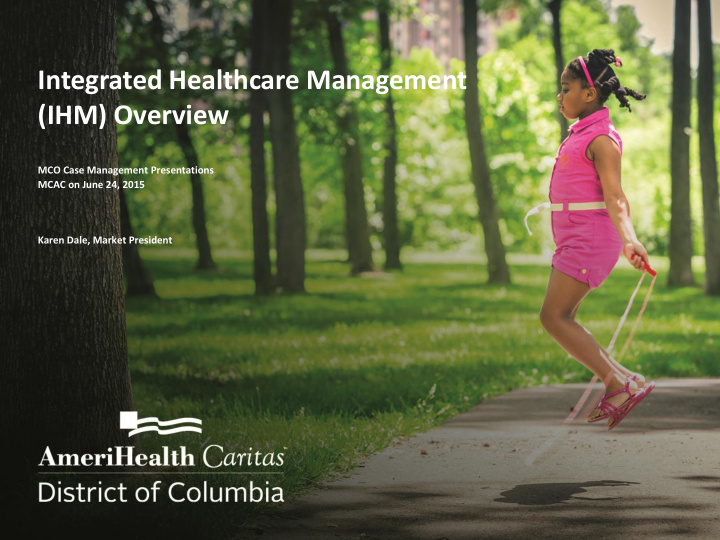



Integrated Healthcare Management (IHM) Overview MCO Case Management Presentations MCAC on June 24, 2015 Karen Dale, Market President
Pillars of Our Strategy Care Management Care Coordination Care Customization Member Centric Member Engagement and Empowerment • Establish frequent contact with member in addition to care management which may include text messages, tablet and a member portal • Go to where the member is and build a reliable, trusted relationship as a partner to achieve wellness • Utilize CLAS standards • Ensure robust array of resources are available to meet psychosocial needs Value added Provider and Community Partnerships • Leverage the strengths of community partners • Engage academic partners for rigorous research and evaluation Informatics Excellence • Utilize as much real-time data as possible • Appropriately target members based on clinical and social determinant data True Integrated Care Management • Ensure every member interaction is leveraged to capture and evaluate physical, behavioral health and environmental challenges • Re-think care management to be a model of member engagement 2
Integrated Healthcare Management (IHM) • Patient-centered approach which addresses the patient’s preferences, concerns, lifestyle, culture, beliefs and readiness - multiple referral points - team-oriented approach • The Program is Flexible and Adaptable to recognize the unique needs of well, chronic and acute populations • all members are eligible for support • interventions are designed to address member’s unique needs to deliver the right services, at the right time, for the right cost • Interventions may include contact by telephone or in-person, education materials (mail, video), referral to community-based support, text messages • Tracking – assessments and results, member engaged, member refused, return mail, COS team contacts 3
Stratification Approach Non-clinical Clinical High Utilizing Patient Profile Ward DxCG Score Homeless Pharmacy – new starts, inconsistent History of complaints medication adherence, multiple prescribers, high utilization of narcotics. Attendance at community events Sub-group level – chronic conditions (newly Receipt of incentives diagnosed versus diagnosed and stable). Household composition Gaps in care – e.g. member with a positive lab Enrollment history (continuous or not) result for HIV and then no claims. ER and ambulance utilization “hot spots” for example for ambulance Future – real time data to support case utilization management efforts through enhancements Medical home utilization versus numerous to CRISP, sharing clinically relevant data from providers provider EMR. Less dependency on claims, to have information to support a timely intervention with a member e.g. short member health questionnaires. 4
IHM Organizational Chart Administrative Director of IHM Assistant IHM Supervisor IHM Behavioral IHM Supervisor Bright Health Supervisor Start/CWSN Case Managers Case Managers Case Managers 10.0 FTEs 3.0 FTEs 9.0 FTEs Rapid Response Care Connectors Community Outreach Care Connectors 10.0 FTEs Specialists 11.0 FTEs Case managers – complete assessments, develop treatment plans, provide disease management education Roles Non-clinical staff – screen, assist with coordinating care, resource Community Outreach Specialists – screen, outreach in-person or telephonic, resource CLAS - The provision of health care services that are respectful of and responsive to the health beliefs, practices and needs of diverse members. 5
Asthma Focus - Pediatric IMPACT Program o Improve management of pediatric asthma, reduce unnecessary ED visits. o Program components include: Shared savings with provider, in-person intensive work with the child and family, ED diversion, 80 referrals per quarter to program Breathe DC o Conducts home assessments for families referred by IMPACT o Provide what is needed e.g. air filter, de-humidifier to improve the environment o PerformRx Health Tablet to deliver targeted educational interventions several tools to measure and improve adherence and improve general and health literacy Children’s Law Center o Many legal problems are health problems o Legal professionals TRAIN healthcare to recognize health harming needs o Healthcare team members IDENTIFY patients’ health harming legal needs by implementing screening procedures DC Department of the Environment o DC Healthy Homes Program, program aimed at identifying and ending environmental health and safety threats and hazards in the homes of families throughout the District o COS team will be trained and deployed to conduct environmental assessments 6
CM Activity Reporting: Current State January February March April May Total Number of Persons in Case Management * 1,485 1,542 1,430 1,461 1,613 Staffing Number of Case Managers 25 25 25 25 25 Number of Social Workers 3 3 3 3 3 Number of Care Coordinators (non-clinical) 16 16 16 16 16 Number of RNs 22 22 22 22 22 Referrals Referrals to Early Intervention/Special Needs CM 20 26 41 27 38 Referrals to Diabetes CM 35 23 71 76 64 Referrals to Asthma CM 78 67 67 49 88 Barriers to Engagement 1. Contacted members are not interested in participating in the program 2. Contacted members express confidence in self-management of their condition 3. Inaccurate member contact information Mitigation Strategies (strategies to increase member participation in case management) 1. Project to improve accuracy of member data - Lexis Nexis 2 . Additional clinical data mining 3. Improving communication messages to support health literacy 4. Plan to utilize text messages for outreach 5. Leveraging outreach team to connect members with a case manager * Total Number of Persons in Care Management reflects only those members with a complete assessment and open case during that month 7
2014 Outcomes 2014 Preventative Measures 100.0% 90.0% 80.0% 70.0% 60.0% 50.0% 40.0% 30.0% 20.0% 10.0% Contact with CM 0.0% No Contact with CM Focus shifts to measuring program impact/effectiveness using established outcome measures and comparing CM engaged members with those members not engaged in the CM program >3 Low Acuity ED Visits 3.0% 2.4% 2.0% >3 Low Acuity ED 1.0% Visits 1.0% 0.0% Contact with CM No Contact with CM 8
Question and Answer
Recommend
More recommend